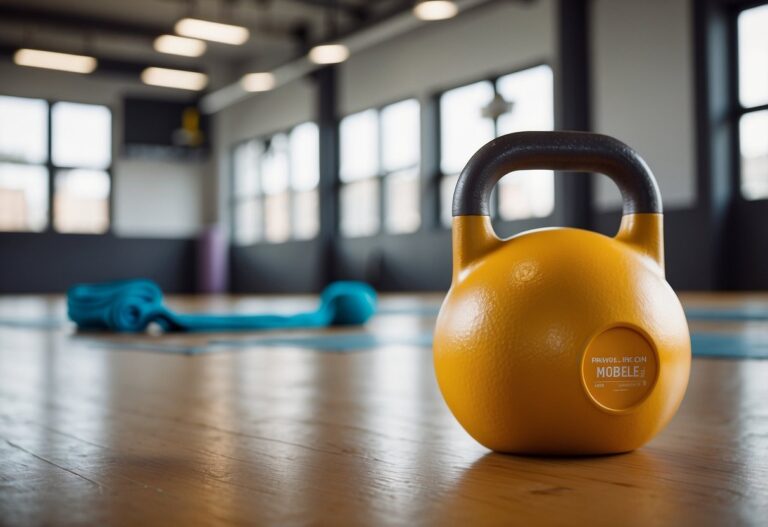Starting your fitness journey can be both exciting and a bit intimidating. When you walk into the gym for the first time, it’s natural to feel uncertain about where to begin or what to do. Gaining some insight into how to approach your first day can make a huge difference. By having a plan and understanding some basic tips, you can set yourself up for success.

It’s important to build good habits from the start. Creating a solid foundation will help you maintain consistency and ensure that you don’t feel overwhelmed. Whether you’re new to exercising or just getting back into a routine, focusing on making manageable changes can lead to long-term success and enjoyment at the gym.
Start with a warm-up
Before you dive into your first workout, it’s important to start with a warm-up. Warming up prepares your body for the exercises ahead, making you less prone to injury.
One simple way to warm up is by marching on the spot for three minutes. Make sure to pump your arms in rhythm with your steps.
You can also try some arm and shoulder stretches. Keep your core engaged and move your arms deliberately to get the best results.
Starting your session with a brief walk or jog for about ten minutes is also effective. This helps to increase your heart rate and get your blood flowing, which is crucial before engaging in more intense exercises.
Taking a few moments to do some basic stretches can help to improve your flexibility and reduce muscle tightness. Remember, a good warm-up can make a huge difference in how you feel during and after your workout.
Stay Hydrated

It’s vital to stay hydrated during your workout. Water helps your body function properly and can improve your performance.
Before you start, drink about two cups of water. This ensures you’re not starting on empty.
During your workout, take small sips regularly. Aim for around 750ml, but this can vary depending on your activity level and duration. For example, you’ll need more water during a long run compared to a short gym session.
After your workout, keep drinking water to replenish what you’ve lost. Keeping a water bottle handy is a great reminder to sip frequently and stay on top of your hydration. For more detailed tips, you can check out this hydration guide.
Focus on Form
When you begin your workout, it’s crucial to focus on your form. Good form helps prevent injuries and ensures that you get the most out of each exercise.
Imagine lifting weights with a hunched back. Not only is this unsafe, but it also means you’re not effectively targeting the muscles you intend to work on.
Ask yourself: are my knees aligned correctly during squats? Are my arms positioned well during push-ups? Small adjustments can make a big difference.
Pay attention to your body’s signals. If something doesn’t feel right, stop and reassess your form. Use mirrors at the gym to check your posture and movements.
If you’re unsure, don’t hesitate to ask a trainer for assistance. They can provide valuable feedback and help you perfect your technique. For more tips, explore essential workout tips to ensure you’re on the right track.
Don’t skip the cooldown

After your workout, it’s tempting to move on with your day, but don’t forget to cool down. Cooling down helps your muscles recover and reduces soreness.
A good cool-down involves light cardio, like walking or slow jogging. This lowers your heart rate and relaxes your body.
Next, stretch your muscles. Focus on areas you worked out, like your calves and hamstrings. Stretching improves flexibility and prevents stiffness.
Remember to breathe deeply during your cooldown. Taking deep breaths helps you relax and delivers more oxygen to your muscles.
Make cooling down a habit. Your body will thank you! For more tips on how to cool down effectively, check out this article.
Listen to Your Body
Listening to your body during the first workout is crucial. Pay attention to how your muscles feel. Are they tight or sore? If so, start with a gentle warm-up.
Notice if your breathing becomes shallow or rapid. This can signal that you’re pushing too hard. Slow down and take deeper breaths.
If you experience any pain, stop immediately. Pain is your body’s way of warning you. It’s better to rest than risk an injury.
Feeling lightheaded or dizzy? This might be a sign you need a break. Drink some water and sit down until you feel better.
Every body is unique. What feels right for someone else might not be right for you. So, trust your instincts.
Set Achievable Goals
When starting a new workout routine, it’s easy to get excited and aim too high. It’s important to set achievable goals that keep you motivated and prevent burnout.
Begin by asking yourself what you want to accomplish. Do you want to run a mile without stopping or do ten push-ups? Make your goals specific and measurable.
Don’t be afraid to start small. If you’re new to exercise, aim for something within reach, like a 10-minute jog or a few sets of light weights. Gradually increase your goals as you progress.
Be flexible. Your first goals might change as you learn what works best for you. It’s okay to adjust them as you go along.
Celebrate your successes, no matter how small. Progress is progress, and recognising it keeps you moving forward. Keep going and you’ll see results.
Wear appropriate gear

Choosing what to wear to the gym can make your workout more comfortable. Shorts and a T-shirt are a classic choice. They allow your body to breathe and move easily during exercise.
Avoid clothes that are too tight or restrictive. You’ll want to stay comfortable while you work out.
For footwear, pick trainers that offer good support. This can help prevent injuries and give you better stability.
If you’re exercising outdoors, consider the weather. In cooler weather, opt for layers. These can be adjusted as you warm up.
Track your progress

On your first day of working out, it’s important to start tracking your progress. Keeping a record helps you see how far you’ve come and where you might need to make changes.
A simple way to do this is with a workout journal. Write down the date, exercises, sets, and reps. For example, jotting down that you did three sets of ten push-ups can be very motivating.
Another method is taking progress photos. Snap a photo of yourself regularly and compare these over time to see how your body changes. These visual cues can be very encouraging.
There are also fitness apps like Fitbod. These apps not only help you track your workouts, but they can also provide recommendations for improving them.
Paying attention to how your clothes fit is another useful method. Notice if your clothes feel looser or tighter after a few weeks. It’s a simple way to track body changes without any tools.
By making a habit of tracking, you’ll stay more motivated and be able to adjust your routine based on your progress.
Mix it up

Keeping your workouts diverse can make a significant difference in your fitness journey. If you do the same routine every day, your muscles will adapt, and progress might slow down.
Try alternating between cardio and strength training. For example, spend one day focusing on running or cycling, and the next on lifting weights or using resistance bands.
Incorporate different exercises to target various muscle groups. Use equipment like treadmills, dumbbells, and exercise balls. This will not only keep things exciting but will also help build a balanced physique.
Changing your routine prevents boredom and can keep you motivated to continue working out.
Stay Consistent
Staying consistent with your workouts is key to seeing progress. It might be tempting to skip a day or two, but it’s important to stick to your routine. Even short, daily exercises can make a big difference over time.
Create a regular schedule that fits your lifestyle. For example, try to exercise at the same time each day. This helps build a habit that’s easier to maintain.
Remember, consistency doesn’t mean perfection. Some days might be more challenging than others, and that’s okay. The goal is to keep moving forward, even if it’s just a little bit each day.
Consider tracking your workouts. This can be as simple as marking an X on a calendar. Seeing your progress can be motivating and help you stay on track.
Involve friends or family in your workouts. Having a workout buddy can make the process more enjoyable and can help keep you accountable.
Mix up your activities to keep things interesting. Try different types of exercises like jogging, yoga, or weightlifting. This can prevent burnout and keep you engaged.
Set realistic goals. It’s easy to get discouraged if your aims are too ambitious. Start small and gradually increase the intensity and duration of your workouts. This ensures you build strength and stamina without risking injury.
Being consistent with your workouts will slowly become part of your daily routine. Stay patient and keep going, even when it feels tough. Your future self will thank you.
Preparation and Mindset
Getting ready for your first workout isn’t just about the physical side; your mindset plays a huge role too. Setting realistic goals and preparing mentally are key steps to make your first workout experience positive and effective.
Setting Realistic Goals
Before you step into the gym, it’s crucial to set goals you can actually achieve. Realistic goals mean setting targets that match your current fitness levels and lifestyle.
Start small, and aim for specific goals like, “I want to jog for 15 minutes” rather than vague aspirations like, “I want to get fit.” Tracking your progress is easier when your goals are clear and measurable.
Break down larger goals into smaller, manageable pieces. For example, if your long-term goal is to run a 5K, begin by running shorter distances and gradually increase over time. Celebrate small victories along the way to stay motivated.
Preparing Mentally for Your First Workout
Mental preparation is just as important as physical readiness. Visualise your workout ahead of time. Picture yourself completing the exercises successfully. This boosts your confidence and reduces anxiety.
Deep breathing exercises can help calm your nerves. Focus on your breath to bring yourself into the present moment. This makes it easier to concentrate on your workout.
Positive self-talk can make a big difference. Remind yourself that it’s okay to start slow and that everyone had a first-day experience. Repeat encouraging phrases to stay motivated.
Create a plan for your workout session. Knowing which machines to use or how many reps to do makes the gym environment less intimidating. Having a plan helps you stay focused and make the most of your time.
Preparation and a positive mindset can make your first workout a rewarding experience.
Starting Your Workout
It’s important to approach your first workout with both excitement and knowledge. Focus on warming up properly and using basic exercises to build a solid foundation.
Proper Warm-Up Techniques
Warming up prepares your body for exercise and helps prevent injury. Begin with dynamic stretches like leg swings or arm circles to get your blood flowing. Spend at least 5-10 minutes on these activities.
Next, include light cardio such as brisk walking or slow jogging. This helps increase your heart rate gradually. Joint rotations are also useful; rotate your wrists, ankles, and neck slowly. These simple movements can make a big difference and are essential for a safe workout.
If you’re at the gym, you may also try using a treadmill or an elliptical machine at a low intensity. This structured routine can help you feel more comfortable and ready to tackle more challenging exercises.
Understanding Basic Exercises
Starting with basic exercises helps you learn proper form and technique. Bodyweight exercises like squats, push-ups, and planks form the foundation of most fitness routines. Squats work your legs and glutes, while push-ups target your chest and arms. Planks strengthen your core, an essential part of overall fitness.
Using light weights can also be beneficial. Start with exercises like dumbbell curls or shoulder presses. Ensure you perform each movement correctly before increasing weight or reps.
If you’re unsure about your form, consider consulting a trainer or using online resources. These steps ensure you build a strong, injury-free foundation for your fitness journey.
Post-Workout Recovery
After your first workout, focusing on proper recovery is key. This involves cooling down your muscles, ensuring proper nutrition and staying hydrated.
Cooling Down and Stretching
Cooling down after a workout helps prevent injury and reduces muscle soreness. Start with light activity like walking for five to ten minutes to bring your heart rate down. Follow this up with stretching exercises.
Stretching helps improve flexibility and reduce tension in muscles. Focus on major muscle groups like your legs, arms, and back. Hold each stretch for about 30 seconds without bouncing. Foam rolling is another great way to relax your muscles and flush out toxins. Regularly practising these post-workout habits will keep you limber and help with long-term fitness goals.
Nutrition and Hydration Tips
Nutrition is crucial for helping your muscles recover and grow stronger. Within 30 minutes after exercising, have a snack that combines protein and carbohydrates. For example, enjoy a banana with peanut butter or a yoghurt with berries.
Stay hydrated by drinking plenty of water. During workouts, you lose fluids through sweat, so it’s important to replace them. An easy way to check your hydration level is by noticing the colour of your urine – it should be pale yellow. You can also drink sports drinks, but these should be used sparingly and mostly for longer or more intense workouts. Keeping your body well-nourished and hydrated ensures you remain healthy and ready for your next exercise session.







